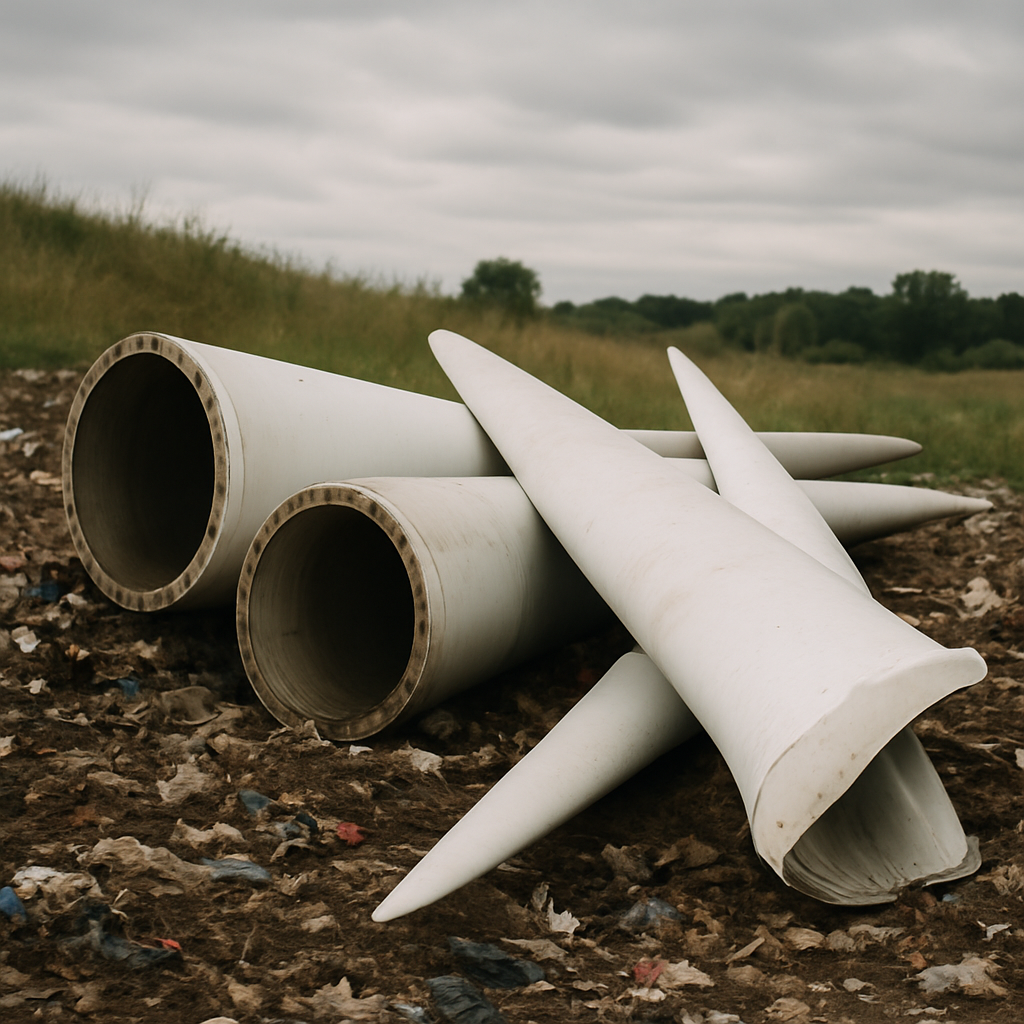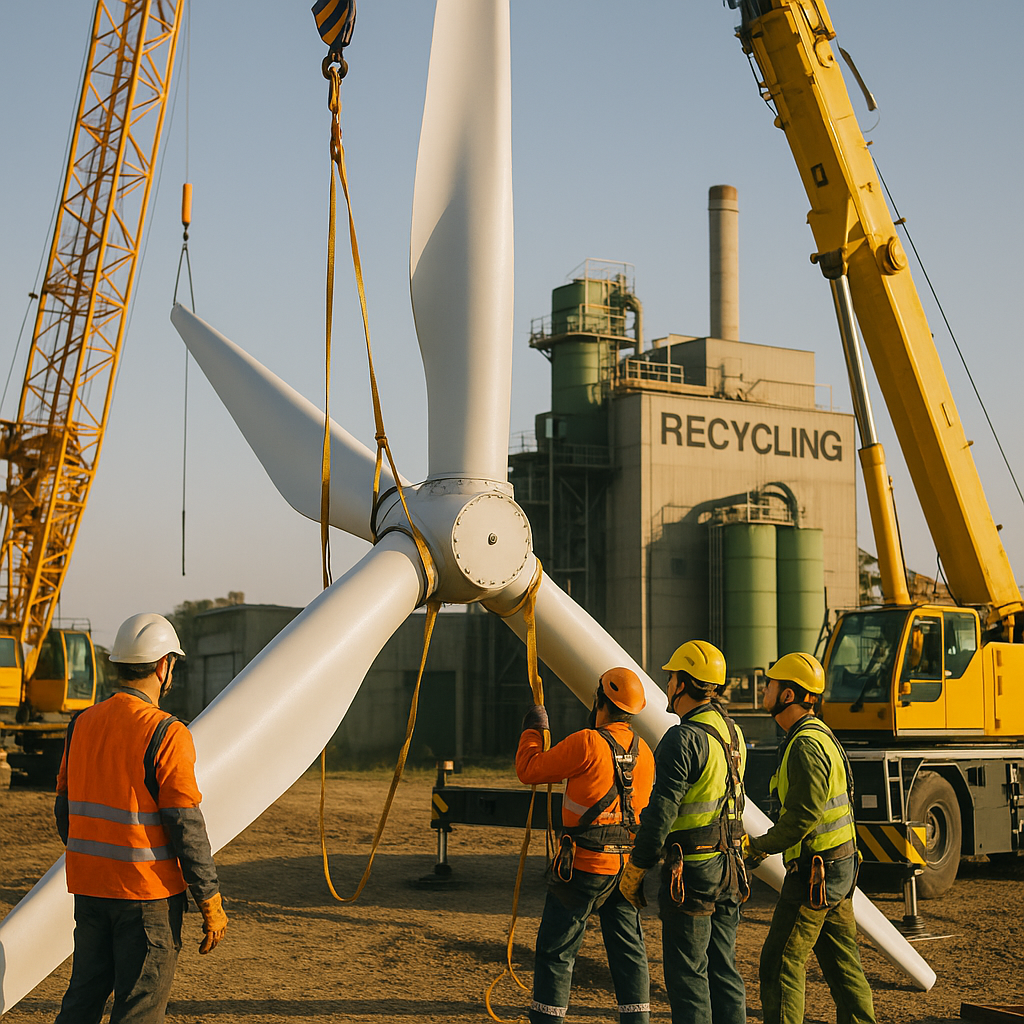5901 Botham Jean Blvd, Dallas, TX 75215
Discover the Challenges of Wind Turbine Blade Recycling in the US
July 30, 2025The United States wind energy sector faces a growing environmental challenge. As wind farms spread across the American landscape, they leave behind massive turbine blades that resist conventional recycling methods. These decommissioned blades present a significant waste management issue.
By 2050, the U.S. is expected to deal with approximately 2.2 million tons of turbine blade waste, according to the National Renewable Energy Laboratory. Currently, most of these materials end up in landfills, creating a concerning contradiction. While wind power generates clean, renewable electricity, it also produces waste components that can occupy valuable landfill space for generations.
The blades themselves pose unique recycling challenges. Made from composite materials like fiberglass, carbon fiber, and thermoset resins, they are designed to withstand harsh weather conditions for decades. This durability makes them particularly difficult to break down or repurpose once decommissioned. The problem is further compounded by their enormous size, with modern blades often exceeding 50 meters in length and weighing several tons each.
What Are the Environmental Impacts of Wind Turbine Blade Waste?

Wind energy is praised for reducing greenhouse gas emissions and promoting renewable power, but disposing of wind turbine blades presents significant environmental challenges. As more turbines are decommissioned, accumulating blades risk undermining some sustainability advances made by the wind industry.
Landfill Burden and Material Persistence
Turbine blades are designed for durability, making them resistant to natural degradation. When disposed of in landfills, they can persist for centuries. The National Renewable Energy Laboratory reports that blades occupy significant landfill space, displacing other waste and straining local disposal capacity. Communities near wind farms are increasingly concerned about long-term storage of composite materials.
Resource Loss and Missed Recycling Opportunities
Wind turbine blades are made from valuable materials such as fiberglass, carbon fiber, and rare metals. Landfilling these materials instead of recycling results in a loss of embedded energy and raw material value. Industry studies indicate that each ton of landfilled blade waste represents a missed opportunity to recover essential industrial inputs for new manufacturing applications.
Potential Leachate and Microplastic Concerns
Although considered non-toxic, there are concerns about potential microplastics and chemical leachate as blades gradually degrade over time. Current research indicates minimal short-term risk, but ongoing monitoring is needed to prevent future environmental hazards due to changing landfill conditions.
Carbon Footprint of Disposal vs. Recycling
The environmental impact of blade disposal is further complicated by the carbon footprint from transporting and burying these large structures. Recycling, especially processes that recover and reuse composite materials, can significantly lower the lifecycle emissions of wind energy systems. According to a 2024 DOE study, innovative recycling can reduce emissions related to blade disposal by over 30% compared to landfill scenarios alone.
Addressing these environmental impacts is crucial for maintaining public support for wind energy and ensuring the sustainability of renewable power. The following sections will explore the current state of recycling technology and policy responses to this issue.
What Are the Current Recycling Options for Wind Turbine Blades?
Wind turbine blades present a unique recycling challenge due to their composition of fiber-reinforced polymer composites. These materials are designed to endure extreme weather for decades, which complicates disposal at the end of their 15–20-year lifespan. Several promising recycling methods are emerging in the United States to address this issue.
Mechanical Grinding
Mechanical grinding is a straightforward approach currently used for blade recycling. This process involves cutting, shredding, and grinding the material to separate fibers from resins.
- The ground material can be repurposed as filler in cement or asphalt production
- Requires significant energy input and specialized grinding machines
- Produces small fiber particles with limited mechanical properties
- Creates potential occupational health risks from dust emissions
Despite its simplicity, mechanical recycling faces economic challenges due to the high cost of processing equipment and the relatively low market value of the resulting materials compared to virgin alternatives.
Pyrolysis Technology
Pyrolysis offers a more advanced approach to recovering both materials and energy from wind turbine blades.
- Involves decomposing organic material by applying heat without oxygen under controlled conditions
- Recovers glass fibers while converting resin into oil, gas, or solid char used as an energy source
- Companies like Carbon Rivers are pioneering glass fiber recovery through pyrolysis
- Produces environmentally hazardous off-gases that must be properly managed
While pyrolysis better maintains the mechanical properties of recovered fibers compared to other methods, it still struggles with economic viability at an industrial scale.
Blade Repurposing
Some innovative approaches focus on repurposing entire blade sections into new products.
- Blades can be cut and transformed into structural elements for buildings, bridges, or outdoor furniture
- The Re-Wind Network project explores using decommissioned blades to create urban infrastructure
- Requires minimal processing, preserving much of the original material value
- Limited by design constraints and the need for specialized cutting equipment
This approach maximizes material conservation but faces challenges in creating sufficient demand for repurposed products.
Chemical Recycling
Chemical methods aim to separate composite materials through solvent-based processes.
- Uses chemical solutions to break down the resin matrix and release fibers
- Preserves the mechanical properties of reinforcing fibers
- Requires careful handling of potentially hazardous chemicals
- Still largely in research and development phases
Researchers at Washington State University developed a method using low-toxicity organic salt in pressurized water to break down blade materials without harsh chemicals.
Fluidized Bed Combustion
This thermal process offers another option for recovering materials from wind turbine blades.
- Mixes fuel and air in specific proportions for combustion
- Recovers glass fibers, though with some strength degradation
- Requires a minimum production capacity of approximately 10,000 tons per year for economic feasibility
- Recovered fibers can be used in applications with lower mechanical demands
Industry pioneers like Veolia are working to scale up thermal processing techniques despite current economic limitations.
While these recycling methods show promise, all face challenges in scaling and cost-effectiveness. The current U.S. infrastructure could process about 90% of the mass of decommissioned wind turbines according to the Department of Energy, but the remaining 10%—primarily blade materials—requires innovative recycling approaches.
The development of recycling technologies using thermoplastic resins instead of thermosets represents a promising future direction, potentially enabling easier recycling of next-generation wind turbine blades.
[[artifact_table]] Comparison of Wind Turbine Blade Recycling Methods [[/artifact_table]]
What Policy and Economic Factors Affect Blade Recycling in the US?

Unlike Europe, the United States operates without federal mandates for wind turbine blade recycling. This policy gap creates a significant difference in approaches to blade waste management across the Atlantic. Several European countries have already implemented or announced bans on landfilling turbine blades to promote alternative solutions, providing clear market signals for recycling innovation.
In the US, economic factors make landfilling the most affordable and accessible option for blade disposal in many regions. Transportation costs pose a significant barrier to recycling, as blades often need to be transported over 1,600 miles to reach recycling facilities, significantly increasing costs and environmental impacts. This economic disadvantage persists because recycling infrastructure is limited and geographically concentrated.
Current market conditions favor disposal over recycling. While blades are non-toxic and safe for landfills, they occupy considerable space. According to the US Department of Energy, the country currently retires approximately 3,000 to 9,000 blades annually, with this number expected to rise to 10,000 to 20,000 blades yearly by 2040. The sustainability of landfilling decreases as disposal volumes increase.
In the absence of federal regulation, several states have started taking action. In 2020, Washington state attempted legislation that would have required manufacturers to implement blade take-back programs. Although unsuccessful, this move reflects a growing trend of state-level policy exploration. Some communities have independently approached city councils to create local blade recycling programs to divert materials from municipal landfills.
The 2022 Inflation Reduction Act offers potential support for recycling innovation. The legislation includes advanced manufacturing tax credits to stimulate domestic recycling growth, which may help overcome the economic barriers currently limiting the development of recycling infrastructure. Industry stakeholders increasingly recognize that policy support is crucial for creating economically viable alternatives to landfilling.
Transportation remains a key cost and emissions source for all recycling methods. While 96 cement kilns operate across the US, only a few accept composite waste as alternative material. This infrastructure gap, along with limited shredding facilities, constrains the scalability of cement co-processing despite its potential environmental benefits. Research indicates that processing one ton of blade material this way could replace 0.4 tons of coal and reduce CO2 emissions from cement production.
Conclusion: The Future of Wind Turbine Blade Recycling in the US

The wind turbine blade recycling industry in the United States is at a promising crossroads. With projections indicating the market will reach $5.6 billion by 2033 and annual blade waste expected to rise to 500,000 tons by 2030, stakeholders in the wind energy sector are embracing circular economy principles to address this challenge. The industry’s shift from disposal to recycling is gaining momentum through technological innovation, cross-sector collaboration, and policy development.
Prize-winning innovations from companies like Cimentaire, WIND REWIND, and Critical Materials Recycling highlight the industry’s commitment to sustainable solutions. Efforts include creating protective coatings for concrete, developing large-format additive manufacturing processes, and recovering rare earth elements. These advancements are laying the groundwork for a robust domestic recycling ecosystem. As these technologies mature and become more cost-effective, the wind energy sector is getting closer to achieving true circularity for its components.
For professional guidance on recycling solutions for wind turbine components or other industrial materials, contact Okon Recycling at 214-717-4083.
